Related Research Articles
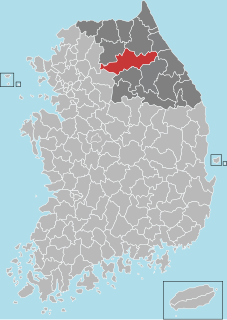
Hongcheon (Hongcheon-gun) is a county and city in Gangwon Province, South Korea. The city lies on the northern bank of the Hongcheon River, southeast of Chuncheon. The terrain of the county is mainly mountainous and contains hot springs in the Hongcheong River valley. The county produces ginseng, maize, and vegetables. As of 2012 the county had a population of 70,401 people in 29,894 households.

Son Byong-hi was a Korean religious leader and independence activist. He was born in Cheongju, in Chungcheong province. He became the third leader of Donghak, an indigenous religious movement founded from 1860 to 1864. His honorary religions name was Uiam and he is referred to hereafter by that name. The founder of Donghak, Choe Je-u, and the second leader, Choe Sihyeong, had both been executed. Haewol, Uiam’s mentor and predecessor, was involved in a peasant revolt in 1894 and he was executed in connection with that in 1898. Thereafter, Uiam assumed leadership of Donghak but was forced to flee to Japan in March 1901. He was accompanied with his brother and chief lieutenant Yi Yong-gu. In Japan, he studied modern western ways which had been adopted by the Japanese after the Meiji Restoration. Up to that point Donghak was highly traditional, opposed to modernization and foreign intervention in Korea. Uiam pivoted from that world view by embracing modernization and accepting help from Japan to achieve that goal. He sent Yi back to Korea in 1902 to act as his liaison. At Uiam’s direction, Yi founded a political organization known as Jungniphoe which was later reorganized as the Jinbohoe. One of the most notable of Jinbohoe activities was the organization of mass hair cutting ceremonies in which Korean men cut off their traditional topknots. Modernization through education was its top priority. It also had a pan-Asian outlook which encouraged Jinbohoe volunteers to aid the Japanese in the Russo-Japanese War particularly in construction of a railroad to aid troop deployment.

Chuncheon is the capital of Gangwon Province in South Korea. The city lies in the north of the county, located in a basin formed by the Soyang River and Han River. There are some large lakes around the city, most notably Lake Soyang and Lake Uiam. The area is renowned for its small river islands, such as Sangjungdo, Ha-Jungdo, Bungeodo and Wido

Gwangju is a city in Gyeonggi Province, South Korea, a suburb southeast of Seoul. The city is not to be confused with the much larger Gwangju Metropolitan City, former capital of South Jeolla Province, South Korea.

Dongducheon is a city in Gyeonggi Province, South Korea.
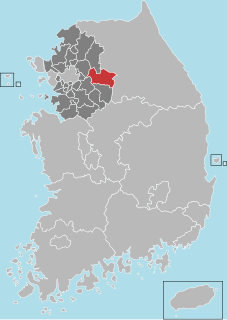
Yangpyeong County (Yangpyeong-gun) is a county in Gyeonggi Province, South Korea.

Dankook University, abbreviated as DU or DKU, is a private research university in Yongin and Cheonan, South Korea. The university was established in 1947. It was the first university established after the National Liberation Day of Korea, and its original location was in Jongno District and Yongsan District, Seoul.
Kukkiwon, also known as World Taekwondo Headquarters, and home of the World Taekwondo Academy, is where the official taekwondo governing organization was established by the South Korean government. It is supervised by the International Sports Division of the Ministry of Culture, Sports, and Tourism.

Apgujeong-dong is a ward of Gangnam-gu in Seoul, South Korea. It is considered one of the wealthiest neighborhoods in South Korea. It was reported that housing price of Apgujeong-dong is approximately US$28,300 per one square meter by Korea Ministry of Land, Infrastructure and Transport in 2019. The dong originates from a pavilion with the same name founded by Han Myung-hoi, a high-ranking government official during the Joseon dynasty. It is an upmarket residential, fashion, shopping, and educational area. The Hanja name translates into "Seagull Pavilion," a reference to his nickname, which itself was a reference and a mark of peace when viewing a group of seagulls flying.
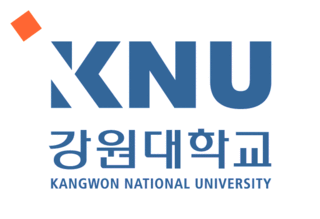
Kangwon National University (KNU) is a national university in Gangwon-do, South Korea. Established as Kangwon Provincial Chuncheon Agricultural College in 1947 in Chuncheon, it extended to a comprehensive university in 1978. KNU serves as the flagship educational institution representing Gangwon-do.

Sema Station is a station on Seoul Subway Line 1 in the city of Osan, South Korea. Services on the Gyeongbu Line also pass through this station.
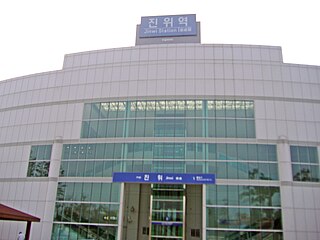
Jinwi Station is a station on Seoul Subway Line 1 in the city of Pyeongtaek, South Korea. Services on the Gyeongbu Line also pass through at this station.
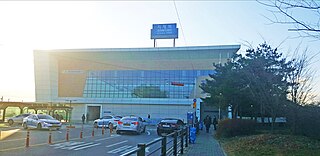
PyeongtaekJije Station(formerly known as Jije station) is a subway station located in Pyeongtaek, South Korea. It serves the SRT and Seoul Subway Line 1. A large E-Mart store is very close to the station. On 24 November 2020, the name was changed to PyeongtaekJije.

Hyehwa-dong is a dong (neighborhood) of Jongno-gu in Seoul, South Korea.

Changsin-dong is a dong, neighbourhood of Jongno-gu in Seoul, South Korea.

Gyeongdong Market or Kyungdong Market, located in Dongdaemun District, Seoul, is one of the largest herbal medicine and ginseng markets of South Korea. Since its establishment in 1960, the market supplies 70 percent of the nation's herbal medicine ingredients and has more than 1,000 related shops and oriental medicine clinics in the area. Gyeongdong Market also serves as a wholesale and retail markets selling agricultural products and fish in about 300,000 square meters, about five times the size of the Seoul Sangam World Cup Stadium.

Olympic Weightlifting Gymnasium located in the Olympic Park area of Seoul, South Korea. It was constructed between August 1984 and April 1986, and hosted the weightlifting competitions for the 1988 Summer Olympics.
Soyang River is a river of South Korea. It is a river of the Han River system. This river has its source in Inje County, Gangwon province.

Tangeum Lake is an artificial lake at Chungju in South Korea.
Hangyeore High School (한겨레고등학교) is a government-funded middle and high school for North Korean refugees adjusting to life in South Korea. It is located in Anseong, Gyeonggi Province, 80 kilometres (50 mi) south of Seoul. It opened on March 1, 2006.
References
- ↑ Young-kwon Kim; Korea (South). Haeoe Kongbogwan; Soo-jung Lee (1978). A Handbook of Korea. Korean Overseas Information Service, Ministry of Culture and Information. p. 576. Retrieved 10 June 2013.
- ↑ Middleton, Dorothy H.; Middleton, William D.; MacDougall, Alan M. (1975). Some Korean Journeys. Royal Asiatic Soc., Korea Branch. p. 69. Retrieved 10 June 2013.
- ↑ Lee, Cecilia Hae-Jin (31 May 2012). Frommer's South Korea. John Wiley & Sons. p. 315. ISBN 978-1-118-33136-1 . Retrieved 10 June 2013.
Coordinates: 37°50′09″N127°40′34″E / 37.8358073°N 127.6761018°E